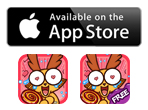PocketGamer: Physical Multiplayer Gaming
Stephen was recently asked to contribute a series of articles for PocketGamer.biz on behalf of the Best of British initiative. Head on over to the official site to read his second article looking at the fun of physical multiplayer gaming. We’ve reprinted the article below:
In my last article for PocketGamer.biz, I talked about the convergence of board games and tablets, and the experiences this generated.
With more and more developers turning their attention to shared local screen space, some have asked: why not just focus on physical board games where similar experiences have existed for many years? The primary difference is the availability of real-time responses. The majority of board games exist within a structured sequence, whereas mobile and tablet devices allow for instantaneous feedback. Players no longer need to track play order or even their scores. More importantly, however, is that designers now have the freedom to introduce their own unique twists otherwise not possible with analog design.
Exploring shared space
Although in its comparatively early days, the tablet has already given rise to two clear divisions of shared screen games: digital board games and touch-screen sports. Digital board games exist as the purest representation of analog design transposed on digital devices, the clearest example being Carcassonne. If you haven’t played Carcassonne – and you really should – it’s a tile-based game focused on building a medieval landscape comprising cities, roads and fields. It won the Spiel des Jahres, spawned many expansions and is typically referred to as the ideal gateway game for those looking into board gaming.
.jpg)
What makes it such a perfect fit for the tablet is the ease with which the board game experience is ported over while removing all the fiddly interactions that can detract from the fun.
A carefully considered UI means it’s always clear whose turn it is, for instance. And tiles are automatically drawn from the selection pool with legal placements presented as recessed slots. Scoring is also a contentious issue near the game’s end, so having an anonymous third party (the tablet) automatically tallying the scores provides a definite resolution. These are all elements in which the board gaming experience can be accentuated through the use of digital technology. It still retains the structured sequence of events in a communal relaxed environment. Touch-screen sports, however, is a whole different kettle of fish.
Embracing physical interactions
Multiplayer games tend to be judged on their level of interactivity – the ability for players to influence the actions of others. A footrace (where the players have no influence on each other) is classified as non-interactive. In contrast, games such as Game Oven’s Fingle, Michael Brough’s O and Rusty Moyher’s Bloop are highly interactive, as your actions will typically interfere with your opponents.
The fun is found in the active sabotage of your opposition while attempting to win, or the sum of the collective efforts. In both cases, these are a singular goal shared by the other players. Although online multiplayer has its benefits, such as an increased player pool and extended networks, virtual competition is still effectively populated by anonymous ghosts. Physical objects simply cannot occupy the same space and this is why the physical presence of other individuals makes local multiplayer so deliciously ripe for exploration.
Both Fingle and FingerTied are prime examples of physical presences acting as an obstacle, requiring individuals to communicate in order to complete the game. In both games, the levels are designed to accentuate the tactile touching of fingers and hands by following predetermined squares. Fingle goes one step further by using moving elements that promote this touching even further.
.jpg)
By requiring the suggestive sliding of fingers into gaps and invading a person’s private sphere, it toys with socially acceptable rituals and the real-life implications. Working in conjunction with each other, players expect a certain level of trust and the games reaffirm this via the hand touching – a source of nonverbal behaviour and communication. Beyond a handshake, we rarely use hand contact unless we know the person – so slow, deliberate movements are perfect for local co-operative games.
Moving beyond the screen
The flipside to this is competitive local multiplayer – each player is out to win at any cost. With all players able to see the screen at the same time, and more importantly each other’s actions, the promotion of dirty tactics is, and should be, actively encouraged.

In Bloop, each player is assigned a colour and the aim is to hit as many of your coloured squares as possible. The squares are randomly distributed among the screen, requiring players to navigate a maze of hands to claim their points. In situations like these, movements are fast and hands bump into each other – recreating the rough and ready rumble of real world sports. In O, the scores are readily visible, leading the losing player to attempt riskier moves in order to catch up. The player is aware of the physical interactions and inhibiting the opposition is a viable tactic.
With both games, physically wrestling and pushing the opposing player away can prevent them from being able to score. These kinds of interactions are incredibly good fun and are a joyous return to childhood aggression. When designing competitive local multiplayer games, we should be actively planning the use of fast, and very physical, actions to promote these experiences.
Looking to the future
The great thing is that we are only just beginning to explore shared gaming experiences within the mobile space. Whether it’s digital board games or touchscreen sports, co-operative or competitive play, it’s clear that the mobile gaming space is veering into new territory.
With titles such as Henry Smith’s SpaceTeam, it’s fascinating to see the boundaries being continually pushed and broken. With each game exhibiting its own specific nuances and the players realising new methods of play, I’m excited to see where local multiplayer will be taken to next!



